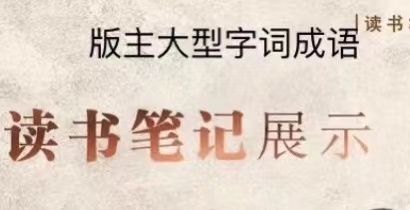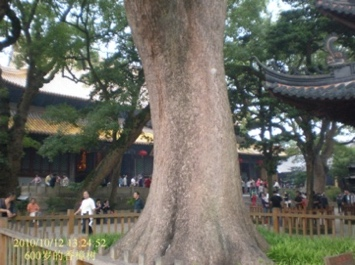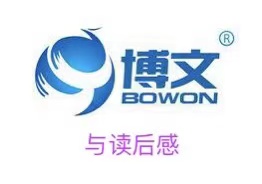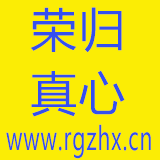Touring Japan
On March 20, 2016, we six from 3 families flied to Japan. Guanyin Airport of Xuzhou had a flight flying directly to Osaka of Japan, which made going and coming very conveniently. March 25 saw us returning to Xuzhou, each spending ¥4300.
First introduce Zhang Youci and Ma Yanrong. Ma Yanrong used to be a classmate of Meilan Zhang’s. Early during the Cultural Revolution in 1968, Ma came to Nanjing and I got to know her. What was interesting was that she decided to accept her classmate Zhang Youci’s love, whose hometown was Erjia, Nantong County, 7 kilometers from Jinyu, where I visited the junior middle school. Therefore, when Meilan and me was distributed to Xuzhou and came here, we four met together, feeling very affectionate to each other, because two girls were girlfriends and classmates and two boys close fellow-townsmen, having much common language. At the end of 1980ies and the beginning of 90ies last century we moved to Xuzhou City successively and in 2000, both of our family bought apartments in Fenghuayuan, and old friends became neighbors in the same housing estate, making us on very intimate terms with each other.
Next introduce Zhang Zhengli, who used to be a younger neighbor of Ma Yanrong and called Yanrong “sixth elder sister”, because Ma was the youngest one of her six sisters. Zhengli also lived in Fenghuayuan and his son Wang Xin wanted to study in Australia and got to know us by Yanrong in order that Li Song could help Wang Xin to do some preliminary work before he went to Melbourne. Therefore, we three families communicated, helped each other and strengthened our friendship gradually.
We travelled in Japan only four days and half, touring the central region. Look at the following map:
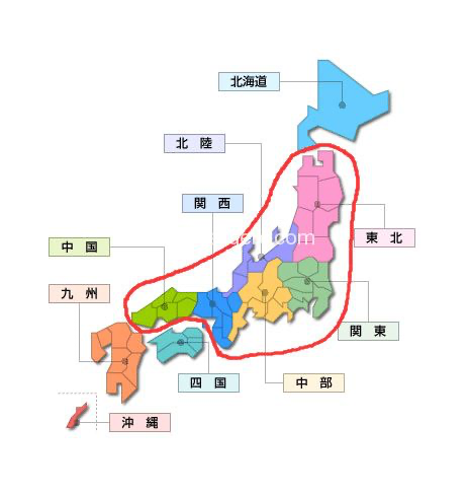
Honshu Island of Japan
The red circle indicates Honshu Island, the greatest island of Japan, also the political, economical, cultural and traffic center. Honshu Island is divided into Northeast(Tohoku东北), Kanto(关东), Central(Chubu) Part(中部), Bei Ling(北陵), Kansai(关西)and Chugoku (中国)six regions. We toured only Kanto(关东), Central(Chubu中部)and Kansai(关西) three regions.
Before introducing the scenic spots, we had been to, I would like to introduce the administrative divisions of Japan. Japan has 47 first tier administrative regions, namely Tokyo-to, Hokkaido, Osaka-fu, Kyoto-fu and 43 counties, subordinates: cities, tings(town) and villages. Aichi-ken is located in the southwestern part of the middle of Honshu Island, whose office is in the city of Nagoya. Aichi-ken is 360 km from Tokyo and 180 km from Osaka. The first night saw us staying in Fuji Sea View Hotel, where scenery beautiful and atmosphere fresh. We took a photo of us six.
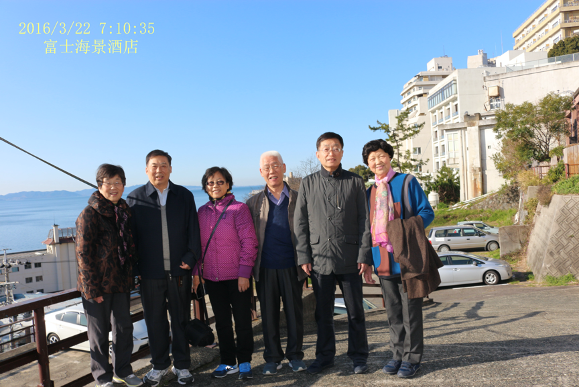
Fuji Sea View Hotel
The following map indicated some of the scenic spots we had been to:
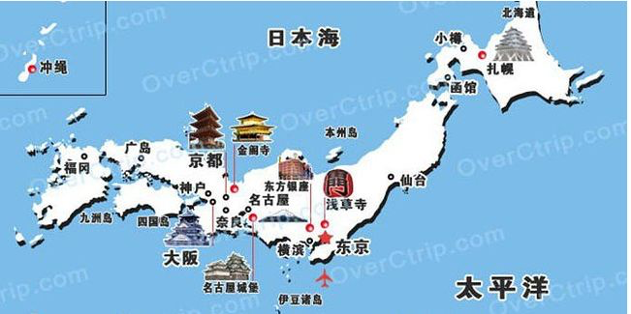
Osaka(大阪)is in the Kansai region, so the airport is called Kansai Airport, which was constructed by marine reclamation land. Before the plane landed, it was gliding above the sea surface, as if it is about to touch the seawater and then landed on the airport runway to slide. The city of Osaka (narrow sense) is the largest city of the western Japan and Osaka is also the region name of Osaka-fu.
Shopping in Shinsaibashi Osaka caused me to have a very bad feeling. Drug & Cosmetic shops being everywhere, the signs of “duty-free” were particularly conspicuous. A lot of Chinese tourists, including me, had blind faith in Japanese goods and the shop was crowded. The salesmen and women were almost all Chinese. Before we entered the shop, the guide advocated some Japanese products so that when we got in we tried to find some of them. It proved that those products were particularly expensive and not so good as what the guide said. We were fooled. It was good that we held the suspicious attitude so that we did not let go of big purchases.
Mount Fuji, a symbol of Japan, the first highest peak, is located 80 km from Tokyo in the west south direction, where cherry blossoms in the spring, mountain breeze in the summer, red leaves full of mountains in the autumn, and white snow covered in the winter. At the northern foot of Fuji, there are Fuji five lakes and in Oshino in the southeast of the lakes there are eight ponds, called Oshino Hakkai, interlinked with one of the five lakes. The tour bus went up and when it was about to reach Three Orders, it had to wait for a very long time because of the huddle of the parking lot there. Before I saw a lot of beautiful photos of Mount Fuji, but when we arrived at its Three Orders, which looks like an ordinary mountaintop covered with snow and whose beauty disappeared, just like the famous poem sentences written by Sushi: “I don't know the true face of Lushan Mountain, only because I am in it.”
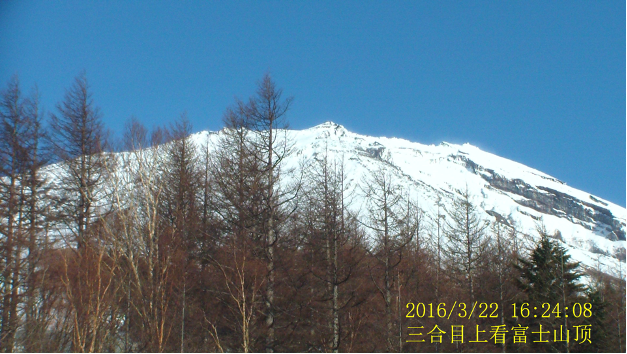
Fuji Top Seen from Three Orders
When we got to Oshino Hakkai, it was 5:30 p.m., and the dusk was about to come. However, we could see the full view of Mount Fuji.
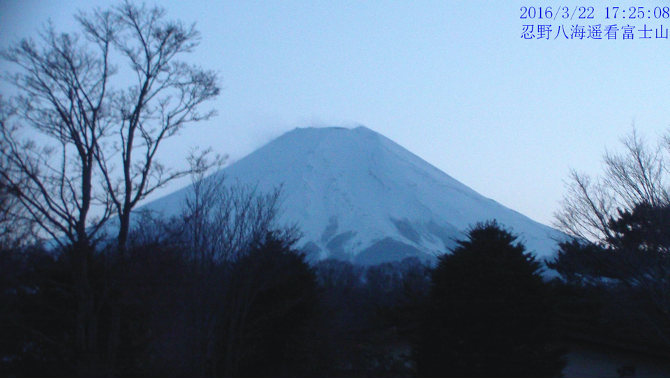
Fuji top seen from Oshino Hakkai
At 13 of March 23 we arrived at the famous scenic spot Sensoji Temple(浅草寺), which is the oldest temple of Tokyo-to.
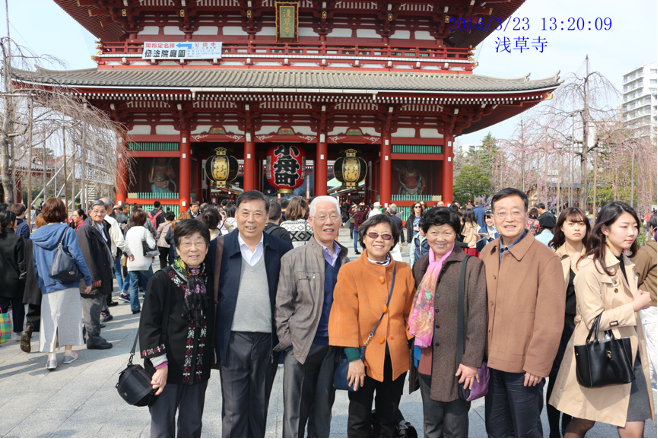
Sensoji Temple(浅草寺)
Kiyomizu Temple(清水寺)is located on the hillside of Otowa-san, which was built in 778 AD and is the oldest temple of Kyoto. Later it was burned a few times, built again and entered world heritage list in 1994.
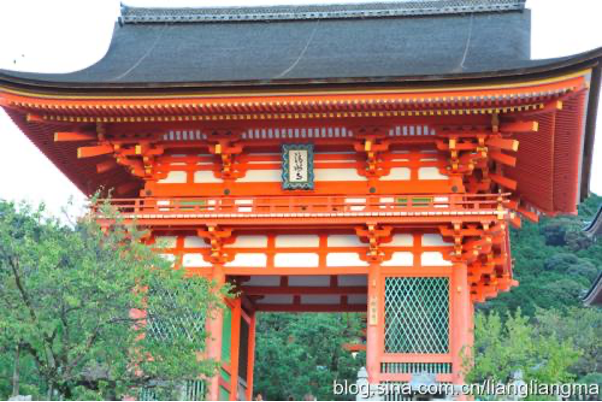

Kiyomizu Temple(清水寺)
Just like Osaka-fu, Kyoto-fu is also in Kansai Region. The city of Kyoto has the largest area among all the counties of Kyoto-fu, and the government of Kyoto-fu is there. In 794 AD Emperor Kammu moved to Heiankyo and before Tokyo as the capital was established Kyoto had been the capital city of Japan. Seen from the mountain top of Kiyomizu Temple, the whole Kyoto appeared in a glance. In Kyoto we also visited Yasaka Shrine(八坂神社). The following photo showed its gate.
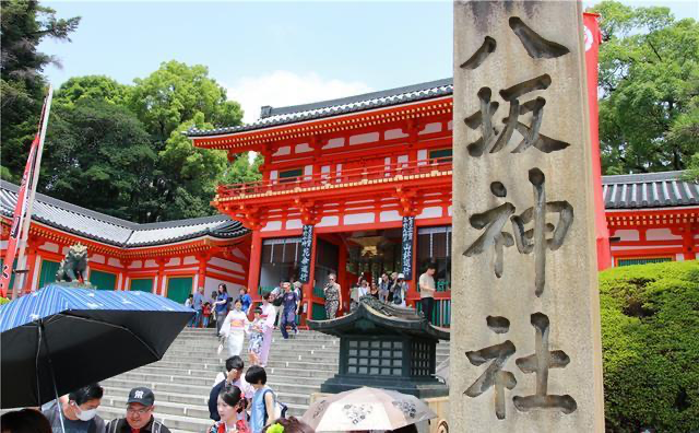
Yasaka Shrine(八坂神社)
On 24 of March we arrived at the New Tokyo City Hall (built from 1986 to 1991), which is the office building of Tokyo Metropolitan Government, similar to Beijing Municipal Government Office Building. The Hall is located in Shinjuku New Area, 243 m high, with 48 floors above the ground and 3 ones in the basement.
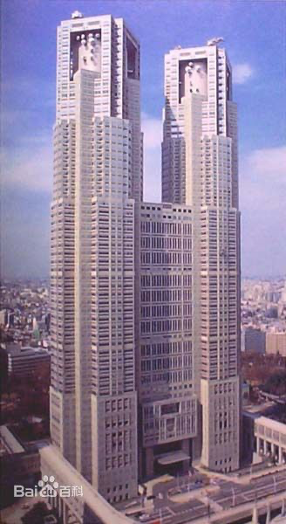
New Tokyo City Hall
The prospect room is on the 45th floor, you can ride a lift directly to it and it would take 45 seconds. We were in the prospect room and we had a panoramic view of the whole Tokyo.
Cocoon Tower Building has its particular modelling, making us surprised and we were glazing at it for a long time. We were overcome by our feelings and took a photo as a memento.
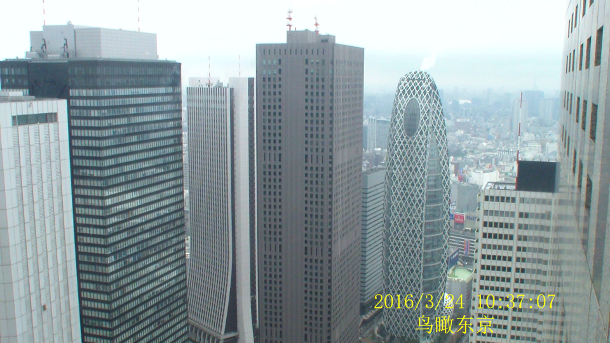
panoramic view of the whole Tokyo
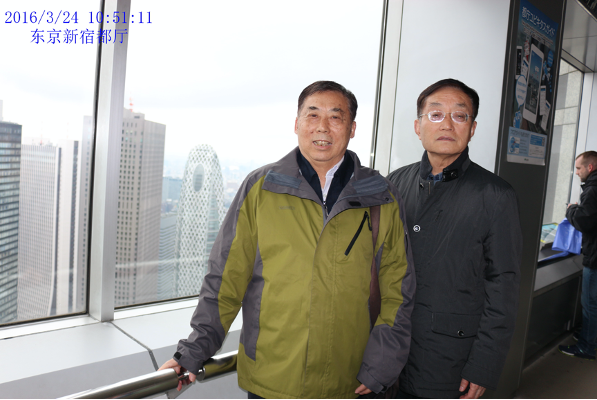
Cocoon Tower Building in the Background
Yokohama is the second largest city to Tokyo and also in Kanto, which is only 28.8 km from Tokyo, half hour’s drive. In the morning of March 24 we wandered in a block of Yokohama, seeing a lot of skyscrapers and busy traffic, which is indeed an international port metropolis, which is why it is named as the second largest city of Japan.
At 9 of March 24 we got to the Imperial Palace in Chiyoda near to Tokyo station. During the Meiji Restoration Period the capital was moved from Kyoto to Edo-gawa, which was renamed as Tokyo later. The former Edo-gawa became the Imperial Palace. The official name of the Imperial Palace was Miyagi from 1888 to 1948. During the Second World War, the Imperial Palace was bombed by American army and in 1968 it was rebuilt according to the original appearance.
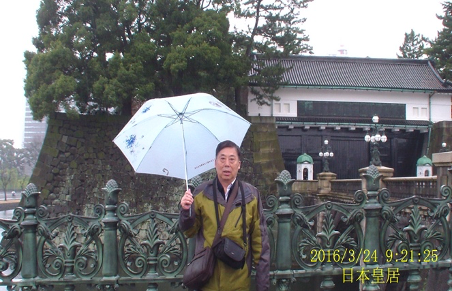
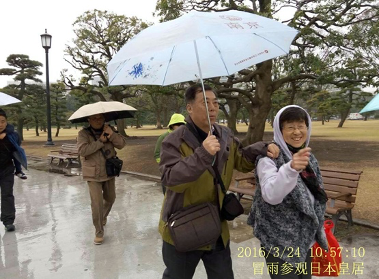
visiting Imperial Palace
At 17 of March 24 we got to Tajiri Town, Hekinan, Aichi County, staying in a grand hotel. The cleanness of the town impressed us very deeply. On the next morning we continued to travel to the Osaka Castle Park, in the middle of which is Fortified Castle with particular modelling.
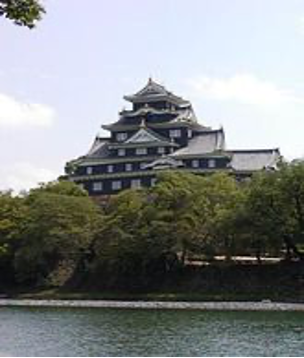
Fortified Castle
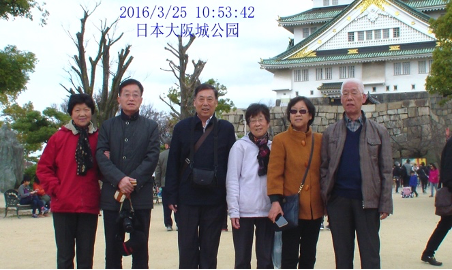
Osaka Castle Park
On the afternoon of March 25 we returned to the Kansai Airport and came to Xuzhou in the evening, completing our 5 days’ journey in Japan.
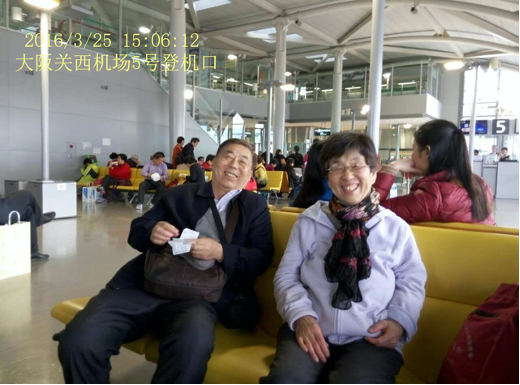
Kansai Airport
Journey to He’nan Province
On the evening of April 18 of 2016 we took a train to Luoyang City and from April 19 to 27 we toured in He’nan Province, having been to Wanxian Mountain, Yuntai Mountain and Anyang City. On the evening of April 27 we returned home and altogether cost us only ¥2260.
This is our independent travel, not joining any group. In Luoyang we enjoyed watching peony flowers. Luoyang was the ancient capital city of 13 dynasties, “capital city of thousands of years and a beautiful peony flower city”. Peony flowers of Luoyang are very large, have all kinds, and all colors, which have the fame of being the finest in the world.
In Section 67, we didn’t mention our travel to Yungang Grottoes in Datong City. In fact, we had been there. Yungang Grottoes were constructed from Wencheng Emperor of North Wei Dynasty, i.e. 460 AD to Emperor Xiaoming 524 AD, lasting more than 60 years. In Luoyang we should go to Longmen Grottoes. Xiaowen Emperor of North Wei Dynasty was afraid that the capital was located in the north and not good for ruling the whole central plains area. Luoyang City was located in the central plains area and had natural advantage. In 493 AD he decided to move the capital from Datong to Luyang and began to construct Longmen Grottoes and the north and the south grottoes were being built at the same time. However, Longmen Grottoes were continued to be constructed during the Tang Dynasty, lasting more than 150 years. As a result, Longman Grottoes had much larger scale, being of great momentum, and reflecting the strongest and most flourish era of worshiping Buddha in the Chinese history.
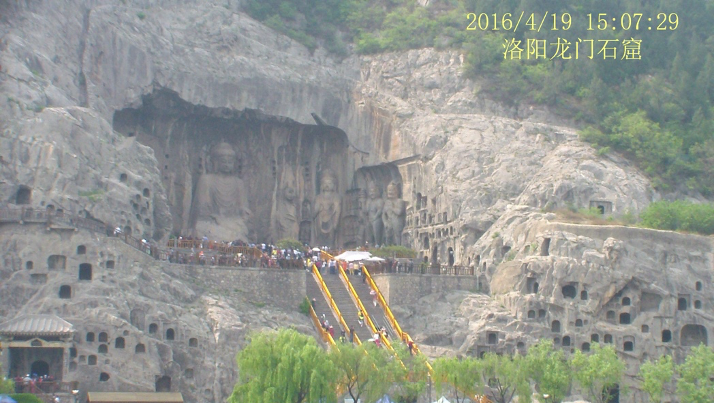
Longmen Grottoes in Luoyang
Wanxian Mount is located in the hinterland of Taihang Mountain in the northwest of Huixian County, He’nan Province. I grew up in the plains and had never seen so many high mountains and lofty hills, and so many cliffs and crags, making me very surprised. Wanxian Mount gathers the essence of red cliff of hundreds of li Taihang Mountain, and the crimson cliffs are over a hundred meters high. Film Village is the good reputation of Guoliang village. We stayed in a peasant hotel there and got to know that there is a hundred-meter cliff in front of the village and a high peak at the back. Since ancient times the traffic has been obstructed and it had been difficult to go out of the mountain. There was only one path to the outside world, which was called sky ladder with 720 steps set in 200 meters high cliff. The narrowest part was only 20 centimeters and you had to lean to one side up or down. Many of the older generation had not been to the outside world. In 1972, villagers began to construct a cliff gallery, the hole of Guoliang, laying the foundation of the new development.

This is the only exposed part of the cliff galary
Danfengou is also a superexcellent spot and it is not difficult to imagine the difficulty of the development engineering. Only when a lot of passageways were constructed could so many travelers come in the fairyland on earth. Jammed with visitors, the rewards must be generous.
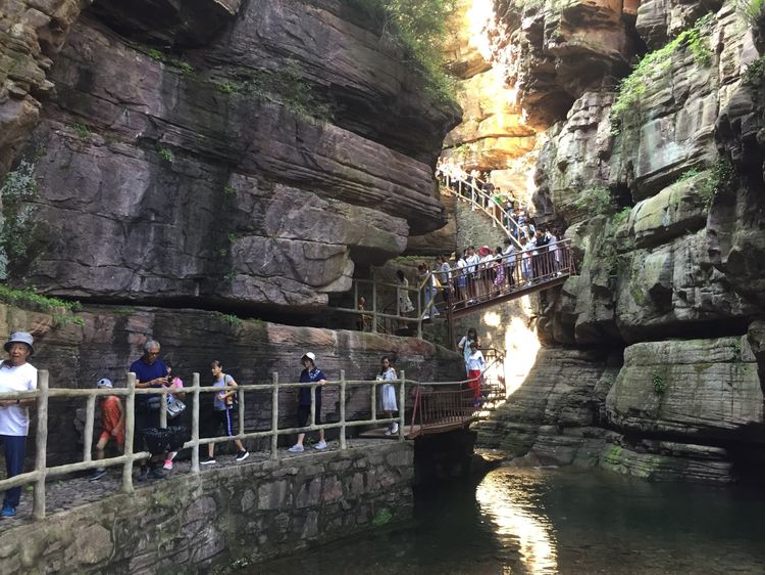
a Section of Danfengou
Hongshi Gorge is the essence of Yuntai Mount, which would take you one and half hours. It is 1500 meters long and at the south end there is a narrow canyon, called “strip of sky” with a fall 60 meters high, called white dragon fall.
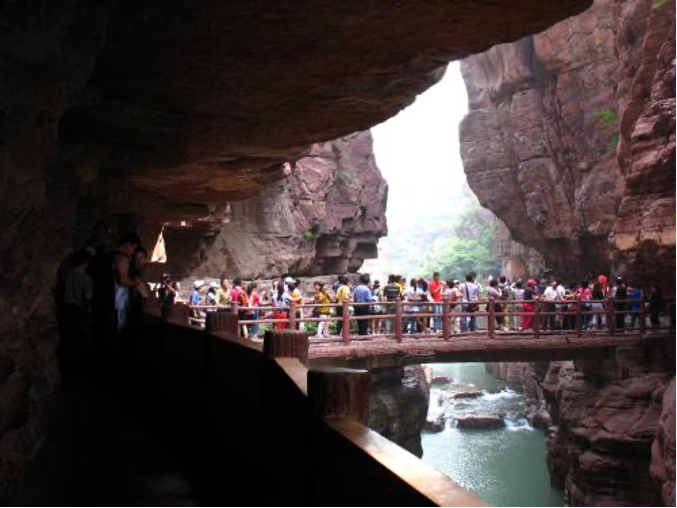
Stone Bridge cross the Canyon
An’yang is located in the north He’nan, where there are famous scenic spots, such as Yinxu, Red Flag Canal, Ma’s Manor and Yuanlin, the tomb of Yuan Sikai. Yinxu is capital city ruins of later stage of Shang Dynasty(1319 BC to 1046 BC). At the end of the twenties of the last century of the Republic of China era, more than 150,000 pieces of inscriptions on bones or tortoise shells and thousands of bronze wares, including the famous Stepmother (simuwu)Tripod, were unearthed, which created quite a stir in the historian circle.
Hongqi (Red Flag) Canal was constructed under the extremely difficult conditions in the sixties of the last century in Linxian County (now Linzhou City), which leads water from Zhang’he River to Linxian through the hillside of Taihang Mountain. People call it “manpower galaxy”. We walked along the canal for a long distance and caused a sincere admiration for such a huge engineering constructed during the difficult and economic backward period.
Ma’s Manor was Ma Peiyao’s mansion, who was the governor of Guangdong Province during the Qing dynasty. It was built during the years of Guangxu Emperor of Qing Dynasty and the early years of the Republic of China and is well-preserved. On Aug 15 of Guangxu 26 (1990), the Eight-Power Allied Forces swept into Beijing, Empress Dowager Ci Xi and Emperor Guangxu fled in panic to Xi’an. In the next year they returned from there, arrived at Anyang and stayed in Ma’s Manor for a night.
Yuanlin is Yuan Shikai’s tomb with Chinese and Western styles and was built from June of 1916 to June of 1918, where he and his wife were buried. Yuan Shikai was the first president of the Republic of China.
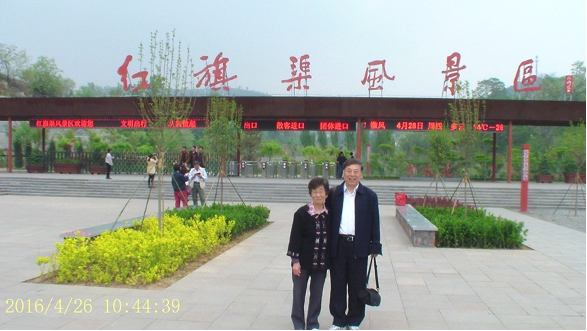
Hongqi (Red Flag) Canal



